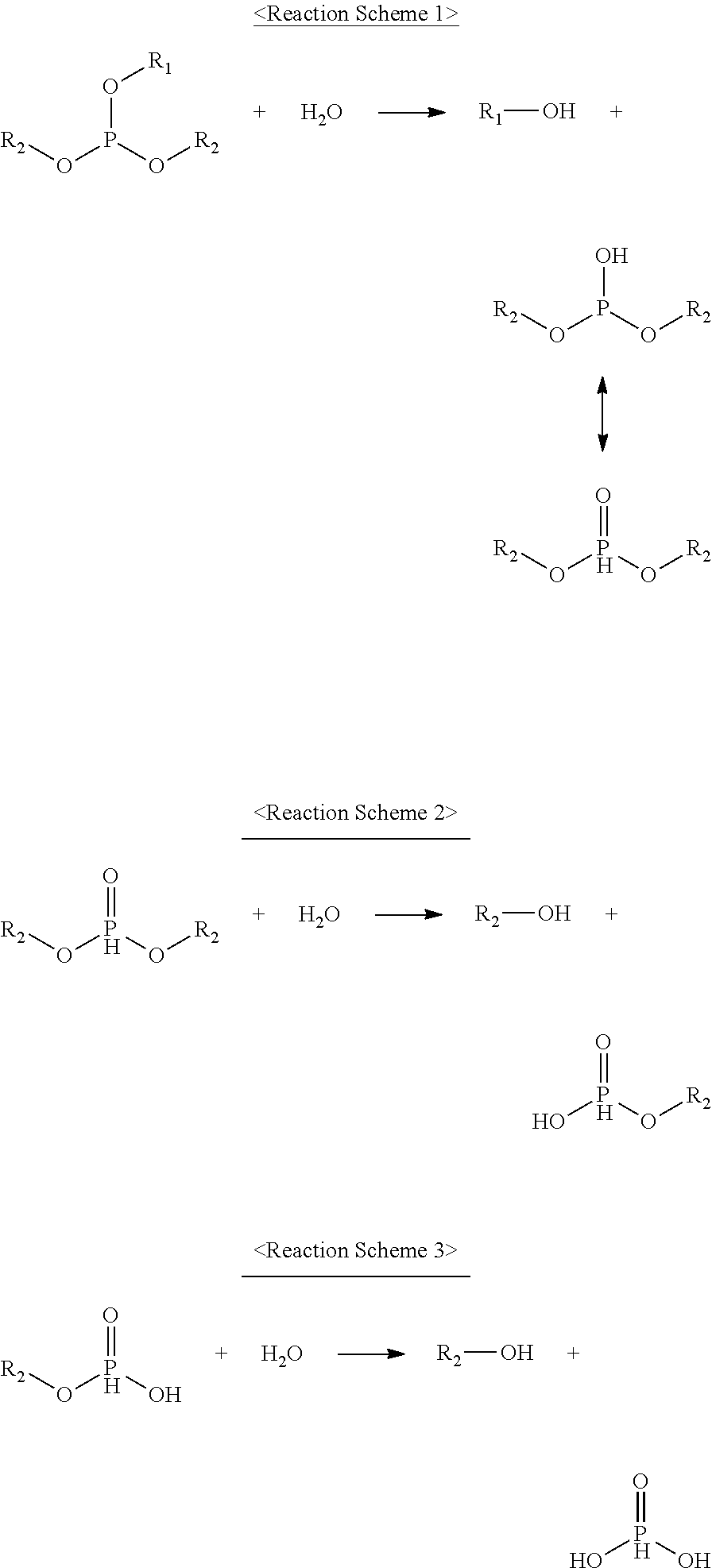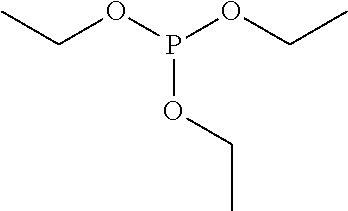Method of preparing vinyl chloride-based polymer composite, vinyl chloride-based polymer composite, and vinyl chloride-based polymer composite composition
a technology of vinyl chloride-based polymers and composites, which is applied in the field of preparing vinyl chloride-based polymer composites, can solve the problems of difficult application of phosphite so far, and achieve the effects of excellent thermal stability, and reducing the decomposition of phosphi
- Summary
- Abstract
- Description
- Claims
- Application Information
AI Technical Summary
Benefits of technology
Problems solved by technology
Method used
Image
Examples
examples 1-1 to 1-5
and Comparative Examples 1-1 to 1-4
[0060]A polymerization device equipped with a 1 m3 polymerization reactor, a reflux condenser which is connected to the polymerization reactor and controls a polymerization temperature, and a pipe for recovering vinyl chloride which is connected to the reflux condenser and releases an unreacted vinyl chloride-based monomer was used to polymerize a vinyl chloride-based monomer as follows.
[0061]First, 390 kg of deionized water was added in the polymerization reactor, and 150 g of polyvinyl alcohol (degree of hydration: 78.5%), 100 g of polyvinyl alcohol (degree of hydration: 40.7%), and 30 g of hydroxypropyl methylcellulose all together were added as a dispersant. Subsequently, 300 kg of a vinyl chloride-based monomer was added, and 30 g of di-(2-ethylhexyl)peroxydicarbonate and 120 g of t-butylperoxy neodecarbonate were added as an initiator. Polymerization was performed while an inner temperature of the polymerization reactor was maintained as show...
examples 2-1 to 2-5
and Comparative Examples 2-1 to 2-6
[0066]100 parts by weight of a vinyl chloride-based polymer composite listed in Table 3 below, 1 part by weight of a mono / dimethyl tin mercaptide composite as a tin-based stabilizer, 1 part by weight of an acryl and methyl methacrylate (MMA) composite as a processing aid, 5 parts by weight of a methyl methacrylate (MMA) and butadiene composite as an impact modifier, 0.5 parts by weight of a fatty acid ester and wax composite as a lubricant, and an additive listed in Table 3 below were blended and mixed using a rolling mill at 185° C. for 3 minutes, thereby obtaining a preliminary sheet having a thickness of 0.5 mm. The preliminary sheet was cut, and then ten cut sheets were stacked one on top of the other and compressed all at once, thereby preparing a sheet having a thickness of 6 mm.
[0067]
TABLE 3AdditiveVinyl chloride-basedContentClassificationpolymer compositeType(parts by weight)Example 2-1Example 1-1——Example 2-2Example 1-2——Example 2-3Example...
examples 3-1 to 3-5
and Comparative Examples 3-1 to 3-6
[0068]100 parts by weight of a vinyl chloride-based polymer composite listed in Table 4 below, 4 parts by weight of a mono / dimethyl tin mercaptide composite as a tin-based stabilizer, 1 part by weight of an acryl and methyl methacrylate (MMA) composite as a processing aid, 6 parts by weight of a methyl methacrylate (MMA) and butadiene composite as an impact modifier, 0.5 parts by weight of a fatty acid ester and wax composite as a lubricant, and an additive listed in Table 4 below were blended and mixed using a rolling mill at 185° C. for 3 minutes, thereby obtaining a preliminary sheet having a thickness of 0.5 mm. The preliminary sheet was cut, and ten cut sheets were stacked one on top of the other, put into a frame having a thickness of 3 mm, and compressed all at once. Then, the compressed sheets were preheated at 185° C. for 2 minutes, heated at 185° C. for 3 minutes under a pressure of 10 kg / cm2, and cooled at 185° C. for 2 minutes under a p...
PUM
| Property | Measurement | Unit |
|---|---|---|
| temperature | aaaaa | aaaaa |
| temperature | aaaaa | aaaaa |
| thickness | aaaaa | aaaaa |
Abstract
Description
Claims
Application Information
 Login to View More
Login to View More - R&D
- Intellectual Property
- Life Sciences
- Materials
- Tech Scout
- Unparalleled Data Quality
- Higher Quality Content
- 60% Fewer Hallucinations
Browse by: Latest US Patents, China's latest patents, Technical Efficacy Thesaurus, Application Domain, Technology Topic, Popular Technical Reports.
© 2025 PatSnap. All rights reserved.Legal|Privacy policy|Modern Slavery Act Transparency Statement|Sitemap|About US| Contact US: help@patsnap.com



